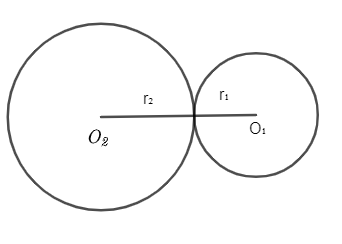
Two circles touch externally. The sum of their areas is $130\pi $sq. cm and the distance between their centres is 14cm. Find the radii of the circles.
A. 11cm & 3cm
B. 1cm & 3cm
C. 11cm & 13cm
D. None of these
Answer
606.6k+ views
Hint: Consider 2 triangles with centre ${{r}_{1}}$and${{r}_{2}}$. We have been given combined area and distance between centres of radius. Substitute there in the sum of areas. Simplify it to a quadratic equation and roots will give the radius of both circles.
Complete step-by-step answer:
Let us consider two circles with centres ${{O}_{1}}$ and ${{O}_{2}}$. Let ${{r}_{1}}$be the radius of circle 1 and ${{r}_{2}}$ be the radius of circle 2.

Given that the distance between the centers of circle 1 and 2 is 14cm.
$\begin{align}
& \Rightarrow {{r}_{1}}+{{r}_{2}}=14 \\
& \therefore {{r}_{2}}=14-{{r}_{1}}\ldots \ldots (1) \\
\end{align}$
Given that the sum of areas of 2 circles is $130\pi $
Let ${{A}_{1}}$ be the area of circle 1 and ${{A}_{2}}$be the area of circle 2.
$\therefore {{A}_{1}}+{{A}_{2}}=130\pi \ldots \ldots (2)$
We know area, \[A=\pi {{r}^{2}}\]
$\therefore {{A}_{1}}=\pi {{r}_{1}}^{2},{{A}_{2}}=\pi {{r}_{2}}^{2}$; cancel $\pi $ from RHS & LHS
$\therefore \pi {{r}_{1}}^{2}+\pi {{r}_{2}}^{2}=130\ldots \ldots (3)$
Substitute equation (1) in equation (3)
${{r}_{1}}^{2}+{{\left( 14-{{r}_{1}} \right)}^{2}}=130$
We know that,
$\begin{align}
& {{\left( a-b \right)}^{2}}={{a}^{2}}-2ab+{{b}^{2}} \\
& \Rightarrow {{r}_{1}}^{2}+{{14}^{2}}-2\times 14{{r}_{1}}+{{r}_{1}}^{2}=130 \\
& \Rightarrow {{r}_{1}}^{2}-28{{r}_{1}}+{{r}_{1}}^{2}=130-96 \\
& \therefore 2{{r}_{1}}^{2}-28{{r}_{1}}=-66 \\
& \Rightarrow 2{{r}_{1}}^{2}-28{{r}_{1}}+66=0\ldots \ldots (4) \\
\end{align}$
Divide throughout by 2 in equation (4)
$\Rightarrow {{r}_{1}}^{2}-14{{r}_{1}}+33=0\ldots \ldots (5)$
The obtained equation (5) is similar to the general equation $a{{x}^{2}}+bx+c=0$. So comparing them we get a=1, b=-14, c=33.
Substitute the values in quadratic equation,
$\begin{align}
& \dfrac{-b\pm \sqrt{{{b}^{2}}-4ac}}{2a}=\dfrac{-(-14)\pm \sqrt{{{\left( -14 \right)}^{2}}-4\times 1\times 33}}{2\times 1} \\
& =\dfrac{14\pm \sqrt{196-32}}{2}=\dfrac{14\pm \sqrt{64}}{2}=\dfrac{14\pm 8}{2} \\
\end{align}$
$\therefore $Roots are $\left( \dfrac{14+8}{2} \right)$and $\left( \dfrac{14-8}{2} \right)$= 11 and 3 cm.
$\therefore $${{r}_{1}}$=11cm
${{r}_{2}}$=14-${{r}_{1}}$=3cm
Radii of two circles are 11cm and 3cm.
Note: When ${{r}_{1}}$=11cm, substituting ${{r}_{2}}$=14-11=3cm. Similarly if ${{r}_{1}}$=3cm, substituting ${{r}_{2}}$=14-3=11cm
So the radius of two circles is 11cm and 3cm, irrespective of where the bigger and smaller circle comes.
Complete step-by-step answer:
Let us consider two circles with centres ${{O}_{1}}$ and ${{O}_{2}}$. Let ${{r}_{1}}$be the radius of circle 1 and ${{r}_{2}}$ be the radius of circle 2.

Given that the distance between the centers of circle 1 and 2 is 14cm.
$\begin{align}
& \Rightarrow {{r}_{1}}+{{r}_{2}}=14 \\
& \therefore {{r}_{2}}=14-{{r}_{1}}\ldots \ldots (1) \\
\end{align}$
Given that the sum of areas of 2 circles is $130\pi $
Let ${{A}_{1}}$ be the area of circle 1 and ${{A}_{2}}$be the area of circle 2.
$\therefore {{A}_{1}}+{{A}_{2}}=130\pi \ldots \ldots (2)$
We know area, \[A=\pi {{r}^{2}}\]
$\therefore {{A}_{1}}=\pi {{r}_{1}}^{2},{{A}_{2}}=\pi {{r}_{2}}^{2}$; cancel $\pi $ from RHS & LHS
$\therefore \pi {{r}_{1}}^{2}+\pi {{r}_{2}}^{2}=130\ldots \ldots (3)$
Substitute equation (1) in equation (3)
${{r}_{1}}^{2}+{{\left( 14-{{r}_{1}} \right)}^{2}}=130$
We know that,
$\begin{align}
& {{\left( a-b \right)}^{2}}={{a}^{2}}-2ab+{{b}^{2}} \\
& \Rightarrow {{r}_{1}}^{2}+{{14}^{2}}-2\times 14{{r}_{1}}+{{r}_{1}}^{2}=130 \\
& \Rightarrow {{r}_{1}}^{2}-28{{r}_{1}}+{{r}_{1}}^{2}=130-96 \\
& \therefore 2{{r}_{1}}^{2}-28{{r}_{1}}=-66 \\
& \Rightarrow 2{{r}_{1}}^{2}-28{{r}_{1}}+66=0\ldots \ldots (4) \\
\end{align}$
Divide throughout by 2 in equation (4)
$\Rightarrow {{r}_{1}}^{2}-14{{r}_{1}}+33=0\ldots \ldots (5)$
The obtained equation (5) is similar to the general equation $a{{x}^{2}}+bx+c=0$. So comparing them we get a=1, b=-14, c=33.
Substitute the values in quadratic equation,
$\begin{align}
& \dfrac{-b\pm \sqrt{{{b}^{2}}-4ac}}{2a}=\dfrac{-(-14)\pm \sqrt{{{\left( -14 \right)}^{2}}-4\times 1\times 33}}{2\times 1} \\
& =\dfrac{14\pm \sqrt{196-32}}{2}=\dfrac{14\pm \sqrt{64}}{2}=\dfrac{14\pm 8}{2} \\
\end{align}$
$\therefore $Roots are $\left( \dfrac{14+8}{2} \right)$and $\left( \dfrac{14-8}{2} \right)$= 11 and 3 cm.
$\therefore $${{r}_{1}}$=11cm
${{r}_{2}}$=14-${{r}_{1}}$=3cm
Radii of two circles are 11cm and 3cm.
Note: When ${{r}_{1}}$=11cm, substituting ${{r}_{2}}$=14-11=3cm. Similarly if ${{r}_{1}}$=3cm, substituting ${{r}_{2}}$=14-3=11cm
So the radius of two circles is 11cm and 3cm, irrespective of where the bigger and smaller circle comes.
Recently Updated Pages
Two men on either side of the cliff 90m height observe class 10 maths CBSE

What happens to glucose which enters nephron along class 10 biology CBSE

Cutting of the Chinese melon means A The business and class 10 social science CBSE

Write a dialogue with at least ten utterances between class 10 english CBSE

Show an aquatic food chain using the following organisms class 10 biology CBSE

A circle is inscribed in an equilateral triangle and class 10 maths CBSE

Trending doubts
Why is there a time difference of about 5 hours between class 10 social science CBSE

Write a letter to the principal requesting him to grant class 10 english CBSE

What is the median of the first 10 natural numbers class 10 maths CBSE

The Equation xxx + 2 is Satisfied when x is Equal to Class 10 Maths

Which of the following does not have a fundamental class 10 physics CBSE

State and prove converse of BPT Basic Proportionality class 10 maths CBSE




